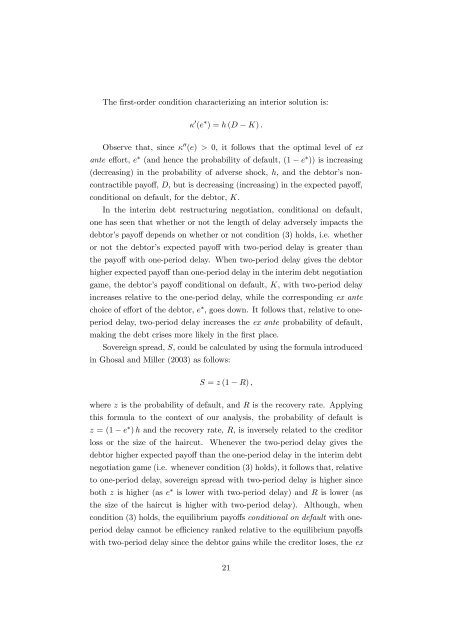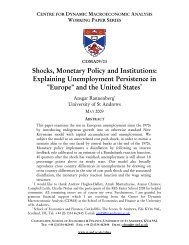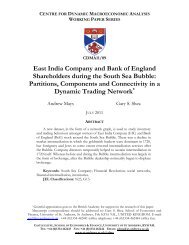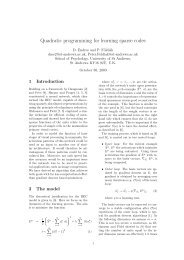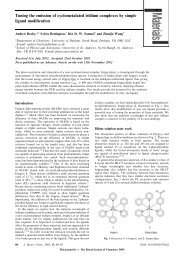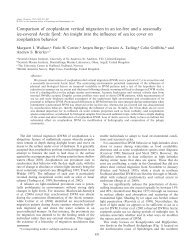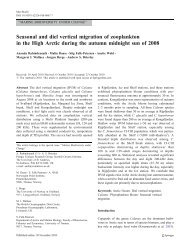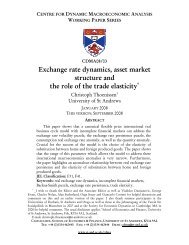Delay and Haircuts in Sovereign Debt - University of St Andrews
Delay and Haircuts in Sovereign Debt - University of St Andrews
Delay and Haircuts in Sovereign Debt - University of St Andrews
Create successful ePaper yourself
Turn your PDF publications into a flip-book with our unique Google optimized e-Paper software.
The …rst-order condition characteriz<strong>in</strong>g an <strong>in</strong>terior solution is:<br />
0 (e ) = h (D K) :<br />
Observe that, s<strong>in</strong>ce 00 (e) > 0, it follows that the optimal level <strong>of</strong> ex<br />
ante e¤ort, e (<strong>and</strong> hence the probability <strong>of</strong> default, (1 e )) is <strong>in</strong>creas<strong>in</strong>g<br />
(decreas<strong>in</strong>g) <strong>in</strong> the probability <strong>of</strong> adverse shock, h, <strong>and</strong> the debtor’s noncontractible<br />
payo¤, D, but is decreas<strong>in</strong>g (<strong>in</strong>creas<strong>in</strong>g) <strong>in</strong> the expected payo¤,<br />
conditional on default, for the debtor, K.<br />
In the <strong>in</strong>terim debt restructur<strong>in</strong>g negotiation, conditional on default,<br />
one has seen that whether or not the length <strong>of</strong> delay adversely impacts the<br />
debtor’s payo¤ depends on whether or not condition (3) holds, i.e. whether<br />
or not the debtor’s expected payo¤ with two-period delay is greater than<br />
the payo¤ with one-period delay. When two-period delay gives the debtor<br />
higher expected payo¤ than one-period delay <strong>in</strong> the <strong>in</strong>terim debt negotiation<br />
game, the debtor’s payo¤ conditional on default, K, with two-period delay<br />
<strong>in</strong>creases relative to the one-period delay, while the correspond<strong>in</strong>g ex ante<br />
choice <strong>of</strong> e¤ort <strong>of</strong> the debtor, e , goes down. It follows that, relative to oneperiod<br />
delay, two-period delay <strong>in</strong>creases the ex ante probability <strong>of</strong> default,<br />
mak<strong>in</strong>g the debt crises more likely <strong>in</strong> the …rst place.<br />
<strong>Sovereign</strong> spread, S, could be calculated by us<strong>in</strong>g the formula <strong>in</strong>troduced<br />
<strong>in</strong> Ghosal <strong>and</strong> Miller (2003) as follows:<br />
S = z (1 R) ;<br />
where z is the probability <strong>of</strong> default, <strong>and</strong> R is the recovery rate. Apply<strong>in</strong>g<br />
this formula to the context <strong>of</strong> our analysis, the probability <strong>of</strong> default is<br />
z = (1 e ) h <strong>and</strong> the recovery rate, R, is <strong>in</strong>versely related to the creditor<br />
loss or the size <strong>of</strong> the haircut. Whenever the two-period delay gives the<br />
debtor higher expected payo¤ than the one-period delay <strong>in</strong> the <strong>in</strong>terim debt<br />
negotiation game (i.e. whenever condition (3) holds), it follows that, relative<br />
to one-period delay, sovereign spread with two-period delay is higher s<strong>in</strong>ce<br />
both z is higher (as e is lower with two-period delay) <strong>and</strong> R is lower (as<br />
the size <strong>of</strong> the haircut is higher with two-period delay). Although, when<br />
condition (3) holds, the equilibrium payo¤s conditional on default with oneperiod<br />
delay cannot be e¢ ciency ranked relative to the equilibrium payo¤s<br />
with two-period delay s<strong>in</strong>ce the debtor ga<strong>in</strong>s while the creditor loses, the ex<br />
21


